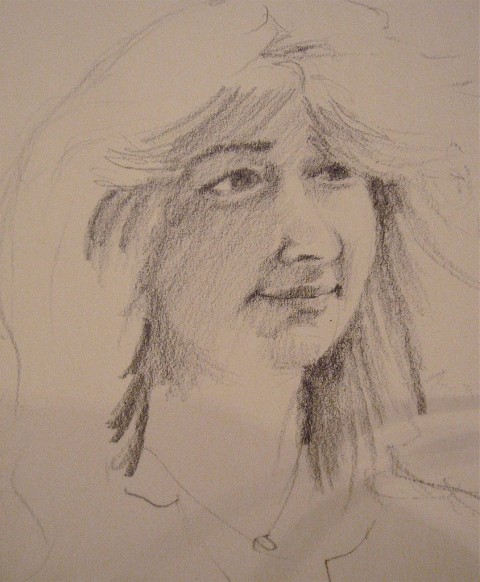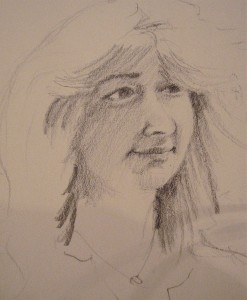
In SmokeLong‘s “Why Flash Fiction?” series, writers and editors explore what draws them to the form. In this column, Anne Weisgerber likens writing a novel in flashes to traversing a museum. Submit your own “Why Flash Fiction?” article or other flash-related essays on our Submittable page!
By Anne Weisgerber
Museums : Novels :: Paintings : Language
When I visit a museum, I flit from point to point and confront paintings. By standing close, I can smell linseed oil, and sometimes discern the artist’s range (when standing fixed in front of the canvas, do the brushstrokes radiate from elbow or shoulder height?) Where did the creator stand? Is anything happening on the surface, or below it? What emerges? I don’t stop at every abstract work, as most require prior knowledge to understand on whose shoulders the work is balanced. In this same way, understanding and appreciating a writer’s range, the control of syntax, cadence, or allusion, helps one see where the artist stood, and adds to the enjoyment of flash fiction.
Portraits : Fiction :: Drawings : Sentences
When it comes to portraiture, painting gets mass appeal. Scenes get human. A great juxtaposition in the world of museums, I think, hangs at The Frick. Flanking a single mantelpiece are both the portrait of Sir Thomas More and that of his mortal enemy and executioner, Thomas Cromwell. These two images reunite and preserve a real tension known by Holbein and preserved via physical placement. This orchestrated staring contest, in a museum full of great art, presents timeless, truthful, moral themes. To me it is exactly like a flash fiction diptych, a counterpoint. The intellect of the viewer compresses and commemorates the conflicts. Through use of space and omission, Holbein emerges, for me, a flash pioneer.
Colors : Words :: Surface : Page
In galleries, I traverse the space happily, wandering, wondering how to enter a conversation and with which object, with whose portrait, over what surface. I might orient myself to the curator’s introductory essay; I will be bored by it and skip right to the players, the art. I am free to roll dice and move myself into the game. Maybe I’m in New York or Paris or London, but I look for what the images say. I code what I see as words, and stop when I am amused, intrigued, or grateful. Flash fictions are gambles of intelligence, wit, language. Individual writers, like painters, invite readers to respond intellectually, emotionally, skeptically. Nothing requires a patron to react, either to a museum’s worth of material or to something from the Western Canon; a Denon Wing or Moby Dick; Crime and Punishment or Getty. One powerful image in a whole museum, one 300-word scene in all the language, can orient me in the deep universe of place and time.
Until I started writing flash, I hadn’t appreciated that I am alive in a time where something exciting, very new and powerful, is happening in the language arts. It’s all happening in small adventurous journals, freed from expectations of syntax, objects, conventions, and curated by pioneering editors. The best of it is beautiful to write, and moving to read.
I’m currently writing a novel in flashes. I had this crazy idea to connect all these literary characters named Leggett (or close variations of the name), from Conrad’s “The Secret Sharer” to O’Hara’s BUtterfield 8. No sooner did I begin plotting across three continents and time-lining the five generations of this saga than I despaired. The plot hit snarl after snarl, the timeline ticked out of tune, and I was completely overwhelmed, paralyzed, and ready to chuck it. Then I took a flash workshop with Randall Brown; I continued to contemplate my novel as I studied flash. Something happened.
I realized I could craft flash miniatures that added up to something bigger if I intended them to, like dabs in a Seurat painting. In this way, my reader at novel distance will see the rose window, hear the orchestra, experience the video wall of calibrated gifs but within scenes, each pane, each cellist, each meme stands alone. A reader might experience my novel as a flash choir, or pointillism, or whatever it winds up being. Flash forces writers to have the nerve to say: THESE WORDS ARE BEAUTIFUL. So I find myself now writing a huge novel in meditative, colorful spoonfuls. I must remember to look at images my words create, both at the linseed tip of my nose and at twenty skeptical paces. Up close, I worry: How can I honor this life with my writing? At practical, admission-paying distances, I fret: What’s in it for my reader?
I only attest that the act of forming sentences and scenes, the punctuation, the pushed and brushed pigment of vowels and verbs and slow-motion ninja gerund phrases has become a vocation. Flash is an artist’s medium; writing it places one where people care about art.
 A.E. Weisgerber has recent fiction in Shotgun Honey, SmokeLong Quarterly, Entropy Magazine, New South, The Journal of Compressed Creative Arts, and her story “Sleeping Beauty: Markson Fangirl” is a Best Small Fictions 2016 Finalist. She reads for Pithead Chapel, reviews for Change Seven Magazine, and is writing her first novel, Unincorporated Area, one flash at a time. Follow her on Twitter @AEWeisgerber, or visit anneweisgerber.com.
A.E. Weisgerber has recent fiction in Shotgun Honey, SmokeLong Quarterly, Entropy Magazine, New South, The Journal of Compressed Creative Arts, and her story “Sleeping Beauty: Markson Fangirl” is a Best Small Fictions 2016 Finalist. She reads for Pithead Chapel, reviews for Change Seven Magazine, and is writing her first novel, Unincorporated Area, one flash at a time. Follow her on Twitter @AEWeisgerber, or visit anneweisgerber.com.

 Try SmokeLong Fitness for two months!
Try SmokeLong Fitness for two months!